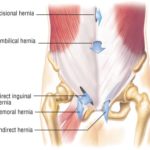1. In this retrospective cohort study, among 107 073 patients, no significant difference was found in complications between patients undergoing laparoscopic surgery and open repair with local anesthesia.
2. Operative time for laparoscopic repair was significantly longer, with a difference of 10.42 minutes compared to open repair with local anesthesia.
Evidence Rating Level: 2 (Good)
Study Rundown: The most common general surgery procedure in the United States is hernia repair, with nearly 1 million performed annually. Traditionally, an open procedure has been indicated for unilateral inguinal hernias, and a laparoscopic procedure has been reserved for bilateral inguinal hernias. However, the indications for laparoscopic repairs have recently expanded to include all inguinal hernias. Outcomes of open repair have been shown to be improved by using local rather than general anesthesia; however, no prior studies have compared laparoscopic surgery with open repair under local anesthesia. The objective of this retrospective cohort study was to evaluate postoperative outcomes of open inguinal hernia repair under general or local anesthesia compared with laparoscopic repair. A total of 107 073 patients who underwent unilateral inguinal hernia repair from 1998 to 2019 were identified in the Veterans Affairs Surgical Quality Improvement Program database. Patients were divided into either open repair with local anesthesia (n=22 333), open repair with general anesthesia (n = 75 104) and laparoscopic repair with general anesthesia (n = 9636). The main outcomes were operative time and postoperative morbidity. Compared with open repair under general anesthesia, laparoscopic repair was associated with a nonsignificant reduction in postoperative complications. Further, no significant difference in complications between laparoscopic surgery and open hernia repair with local anesthesia was found. Operative time was significantly longer for laparoscopic compared with open repair under local anesthesia, with a time difference of 10.42 minutes. A major strength of this study was its efforts to address bias from unmeasured confounding variables, including bootstrapping, probabilistic sensitivity analysis and a 2-stage least-squares analysis. A limitation was that this study could not compare hernia-specific outcomes such as inguinodynia or recurrence.
Click to read the study in JAMA Surgery
Click to read an accompanying invited commentary in JAMA Surgery
Relevant Reading: Comparative perioperative and 5-year outcomes of robotic and laparoscopic or open inguinal hernia repair: a study of 153 777 patients in the state of New York
In-Depth [retrospective cohort]: This study evaluated postoperative outcomes of open inguinal hernia repair under general or local anesthesia compared with laparoscopic repair. The main outcomes included operative time and postoperative morbidity, which were compared using quantile regression and inverse probability propensity weighting. A total of 107 073 patients (106 529 [99.5%] men) who underwent unilateral inguinal hernia repair between 1998 and 2019 were included with a median age of 63 years (IQR 55-71). Patients were divided into three groups for comparison, including open repair with local anesthesia (n = 22 333), open repair with general anesthesia (n = 75 104), and laparoscopic repair with general anesthesia (n = 9636). When compared with open repair under general anesthesia, laparoscopic hernia repair was associated with a nonsignificant reduction in postoperative complications (0.15%; 95% CI, -0.39 to 0.99; P = .22). Additionally, no significant difference in complications between laparoscopic surgery and open hernia repair with local anesthesia was found (-0.05%; 95% CI, -0.34 to 0.28; P = .70). Operative time was found to be similar between the laparoscopic and open hernia repair under general anesthesia groups (4.31 minutes; 95% CI, 0.45 – 8.57; P = .048). However, operative times between the laparoscopic group and the open repair under local anesthesia group differed and were significantly longer for the laparoscopic group (10.42 minutes; 95% CI, 5.80 – 15.05; P < .001).
Image: PD
©2022 2 Minute Medicine, Inc. All rights reserved. No works may be reproduced without expressed written consent from 2 Minute Medicine, Inc. Inquire about licensing here. No article should be construed as medical advice and is not intended as such by the authors or by 2 Minute Medicine, Inc.


